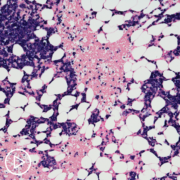Bispecific Antibody Therapy | What Is the Treatment Duration and Response?
Bispecific Antibody Therapy | What Is the Treatment Duration and Response? from Patient Empowerment Network on Vimeo.
What can myeloma bispecific antibody therapy patients expect for treatment duration and response? Nurse practitioner Alexandra Distaso from Dana-Farber Cancer Institute discusses treatment factors that may impact response, common monitoring tests during treatment, and what might be considered an ideal therapy response.
Alexandra Distaso, MSN, FNP-BC is on the Multiple Myeloma Nursing Team at Dana-Farber Cancer Institute.
See More from The Care Partner Toolkit: Bispecific Antibodies
Related Resources:
Transcript:
Katherine:
How long will a patient be on a therapy like this?
Alexandra:
So, we still don’t know exactly the long-term duration of response. I think the most recent update we have was a median of 18 to 22 months was the last report. Which is a great response for what we have in myeloma.
Katherine:
So, does the length of time a patient is on a therapy depend on the patient themselves, their comorbidities, et cetera?
Alexandra:
Sometimes their comorbidities, but it is usually more just how their myeloma responds. So, every month when you’re coming in for therapy, even if your therapy is weekly or biweekly, every month, we’re monitoring your myeloma markers, and every month we’ll go over those markers to make sure we’re still seeing a good response. Usually, we’ll do a PET scan or a skeletal survey to also monitor everyone’s bones and any other lesions, they may have.
Katherine:
What is considered an ideal response?
Alexandra:
An ideal response. A lot of times we’re seeing everyone’s light chains go to even an undetectable level. So, even if we see some partial responses where the light chains were, let’s say they were 100 and they’re going down into the normal range, that’s still wonderful.
If it stayed like that for months, we wouldn’t make any changes. But best-case scenario, we see them go to a level that we can’t detect them in the blood work.













